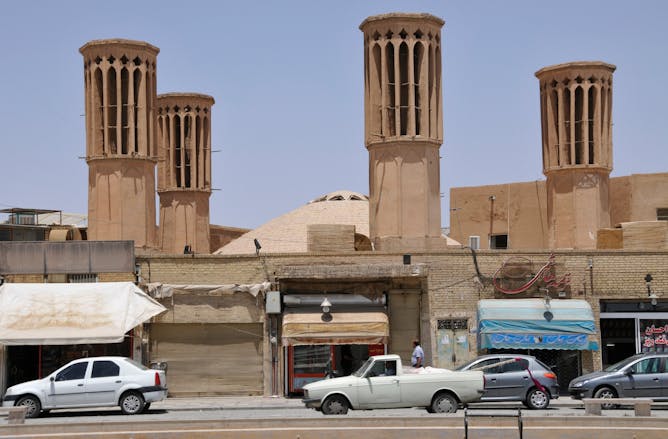|
|
|
|
Last week, during the peak of the brutal heat wave that baked much of the western U.S., the coolest place in my San Francisco apartment was the floor in my housemate’s bedroom. So that is where I sat and worked and even napped when I couldn’t take the heat anymore. The skyscrapers and houses of San Francisco, like buildings in many cities around the world, are simply not designed to handle hot days. This idea of a mismatch between architecture and climate is the topic of this week’s episode of The Conversation Weekly, a podcast that I co-host and which returns today after taking a summer break.
The episode explores how 20th century Western styles of architecture that rely on concrete and glass spread around the world, and in doing so, usurped local building techniques that are better suited to hotter climates. My co-host, Gemma Ware, and I spoke with researchers from Nigeria, Iraq and the U.S. about what makes for a well-designed building, and how some architects are starting to use ancient building principles to stay cool.
You can listen by following The Conversation Weekly on Apple Podcasts or Spotify for new episodes every Thursday, or find other ways to listen here.
Tomorrow, we’ll be releasing our weekly news quiz. If you’d like to receive an email alert when it’s available Friday morning, please sign up here. If you were unable to sign up last weekend because of a technical glitch, we apologize and would appreciate if you would try again.
Also today:
|

|
Daniel Merino
Assistant Science Editor & Co-Host of The Conversation Weekly Podcast
|
|

Windcatchers in Iran use natural air flow to keep buildings cool.
Andrzej Lisowski Travel/Shutterstock
Gemma Ware, The Conversation; Daniel Merino, The Conversation
Follow The Conversation Weekly podcast for new episodes every Thursday.
|
Science + Technology
|
-
Ivan Erill, University of Maryland, Baltimore County
Phages, or viruses that infect bacteria, can lie dormant within chromosomes until they’re triggered to replicate and burst out of their hosts.
-
Sascha Meinrath, Penn State
Ensuring that billions of dollars of federal funding for broadband service are well spent – and that consumers get what they pay for – comes down to knowing the actual speeds internet users experience.
|
|
Environment + Energy
|
-
Kevin Trenberth, University of Auckland
A climate scientist explains the forces behind the summer’s extreme downpours and dangerous heat waves, and why new locations will be at risk in the coming year.
|
|
Education
|
-
Perry Zurn, American University
A philosophy professor looks at the learning styles of different creatures to gain insight into curiosity among human beings.
|
|
Politics + Society
|
-
Naomi Cahn, University of Virginia
States taking the strictest stands against abortion tend to have among the worst statistics in the nation on child and family well-being.
-
Mikkel Dack, Rowan University
Russian actions in occupied Ukraine are following a plan modeled on how the Soviet Union dismantled Nazi influence in Germany after World War II – including arrests and revised school lessons.
-
Christopher Michael Faulkner, US Naval War College
As Ukraine retakes parts of its northeastern region from Russia, the Kremlin continues to increasingly look to private military companies to fill in military power gaps.
-
Kathleen Frydl, Johns Hopkins University
The United States came in 41st worldwide on the UN’s 2022 sustainable development index, down nine spots from last year. A political historian explains the country’s dismal scores.
|
|
Ethics + Religion
|
-
Ki-Eun Jang, Fordham University
The Bible is full of stories about migrants. That doesn’t mean it has a simple takeaway message about them.
|
|
|
|
|
|
| |
| |
| |
| |
|
|
|
|
|
|
|